What is the 1-2-2 Press?
The 1-2-2 Press is normally a ¾ court press with the defense in a 1-2-2 setup. One player is the point who will put the initial pressure on the ball as it comes up the floor. Two players will start around the half-court line. These two players are going to be the 2nd player to trap the ball with the point. Or they are going to be covering the middle of the floor. This will depend on the location of the ball.
The last two players will start somewhere around or above the 3-point line. These two players are going to either prevent a forward sideline pass or be the rim protector. The back two players should not be moving up the court for any reason. The 1-2-2 Press is really about the front 3 players getting up and trapping with having the two back players as protection.
Advantages of the 1-2-2 Press
1) Good Rim Protection
A major reason of using the 1-2-2 Press is the ability to play two bigs at the same time. The two bigs being in the back of the press ensures a rim protector will always be there. Even if the offense is able to beat the press, a good rim protector can prevent easy baskets.
The two back players are only required to cover half the floor. Because they are not having to run around all over the court, they are able to stay relatively close to the basket. Good rim protectors can give a press an added benefit because the offense can not score even if they beat the press. By having that last player always at the rim gives the offense an additional problem before they can score the ball.
2) Easy Rotations
The 1-2-2 Press basically cuts the floor in half. Other then the point player of the press, the other 4 players are all going to stay on their side of the court. Removing the point player from the group, the other 4 are either going to be on the sideline when the ball is on their side or the middle when the ball is on the opposite side of the floor.
In comparison to other presses, the 1-2-2 has the least amount of player movement defensively. Once the players are in their defensive spots, they are pretty set for the possession. This can help to reduce mistakes because the players do not have to rotate much. This makes the press a simple press to learn. There are really only two spots each player is supposed to be and depending on where the ball is at will determine each player’s location in the press.
3) Good Secondary Coverage on Traps
The setup of the 1-2-2 Press provides middle and sideline cover if a trap by two of the front three players occur. The 3 passes available to a trapped offensive player is the sideline, middle, or backwards pass. The sideline pass is covered by the back player. The middle pass is covered by the opposite guard. The only passes open for a trapped player is the backwards pass or some type of skip pass.
The backwards pass does not hurt the defense. But some offenses will have the backwards player run ahead of the trap leaving this option unavailable. This leaves the only pass out of the trap being a skip pass. Skip passes coming out of traps are not always completed at a high percentage. Low skip passes in presses should lead to turnovers and steals.
A good trap needs the closest passes out of the trap to be covered to make the trap as effective as possible. The 1-2-2 press by design has the closest passes covered. And these passes are covered early with the defensive positioning. If the 1-2-2 press is able to get traps, then it is going to be very effective due to the secondary coverage.
Disadvantages of the 1-2-2 Press
1) Middle of the Floor is Open
The setup of the 1-2-2 press covers the sideline well but leaves the middle wide open. There is no player starting in the middle of the floor. The backside players are responsible for rotating into the middle. By leaving the middle of the floor open, the offense has a definitive place to attack the press. The back and forth of the press is whether the defense can keep the offense from getting the ball into the middle.
The 1-2-2 press wants the ball on the sidelines to trap. The players are setup out on the sidelines to make it really easy to trap once the ball gets there. The problem with the 1-2-2 press is getting and keeping the ball out of the middle because that is where the offense has space to run into. The young player coaching advice of run to where the defense is not will lead the young player right to the middle of the press and the floor. This is the major problem of the 1-2-2 press.
2) All Players have to Cover a Lot of Ground on Ball Reversals
Even though the players do not have to cover a lot of the court, all of the players will be moving on any ball reversal. Once the ball is on the sideline, all players should be on that side of the court. A quick ball reversal will force all players on the sideline to sprint to the middle and all players in the middle of the court will have to sprint to the sideline.
A quick ball reversal could have a second quick pass up the sideline to beat the press. An easy press break for the 1-2-2 is a quick ball reversal. Then a pass either up the sideline or to the middle. Then as the defense reacts to this pass, the offense throws the ball to the other.
So, a ball reversal to a forward sideline pass to a pass into the middle will break the press with ease. Also, a ball reversal to a middle pass to a pass up the floor back to the sideline where the middle pass came from.
The defensive players do not have to cover a lot of ground but every player has their responsibilities change with any ball reversal. This leaves openings for through passes in the defensive movements. Some presses keep certain players in the same spots no matter where the ball is at. The 1-2-2 press does not. And because of this it can make the press hard to be effective on ball reversals.
3) Ball in Middle of Floor Beats Press
The middle of the floor is open. If the offense is able to pass the ball into the middle of the 1-2-2 press then the press will collapse into the middle which leaves the sidelines now open. The success and failure of the press depends on keeping the ball out of the middle of the court. A middle pass is going to get the ball past the front three defenders. This usually means the offense will have 3 players attacking the back two.
The offense having the ball in the middle gives them the ability to attack the basket or have kick out chances going to both sides of the court. This gives the defense too much court to defend. The offense should then be able to get an open shot once they get the ball into the middle of the court. At minimum, the offense will cause the defense to retreat back into the half-court and abandon the press for that possession.
Positions of the 1-2-2 Press
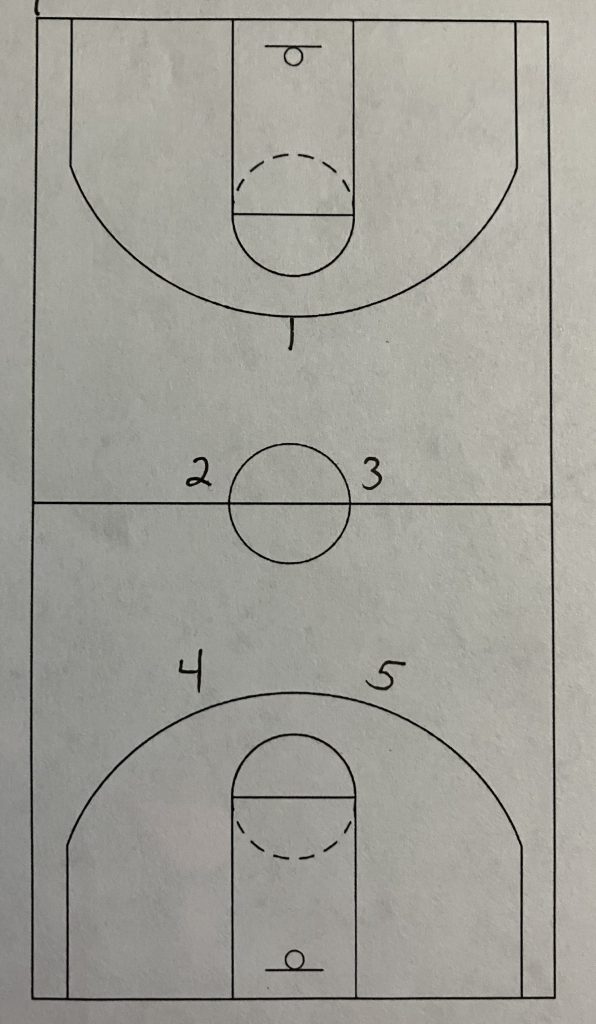
The initial setup is the point up front. Then two guards around the half-court line. These two players may be moved back to try and trap just across half-court. So the 1-2-2 press is normally a ¾ press. Some teams may move it farther back somewhere between a ½ court to ¾ court press. The two back players are around or just above the 3-point line.
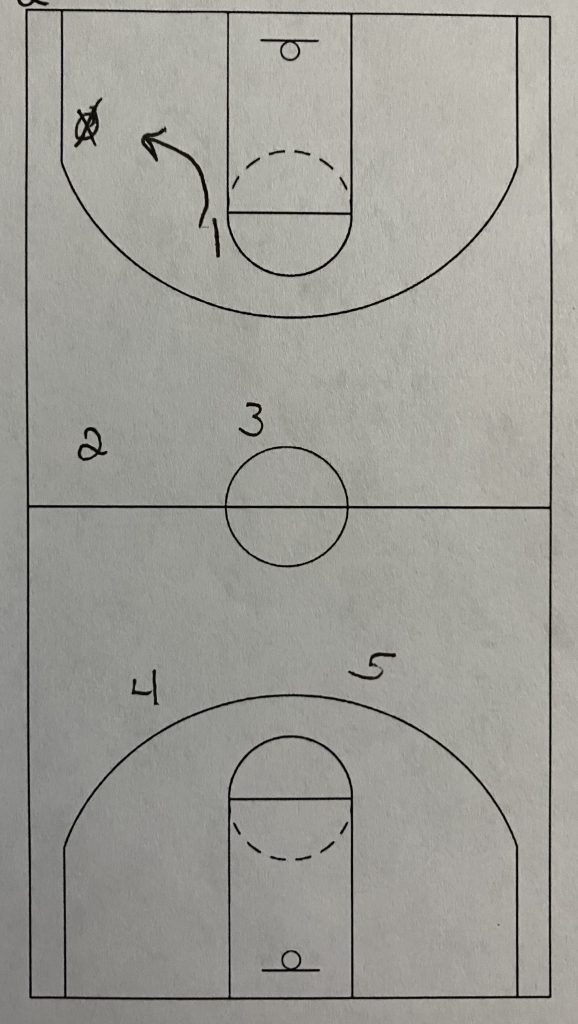
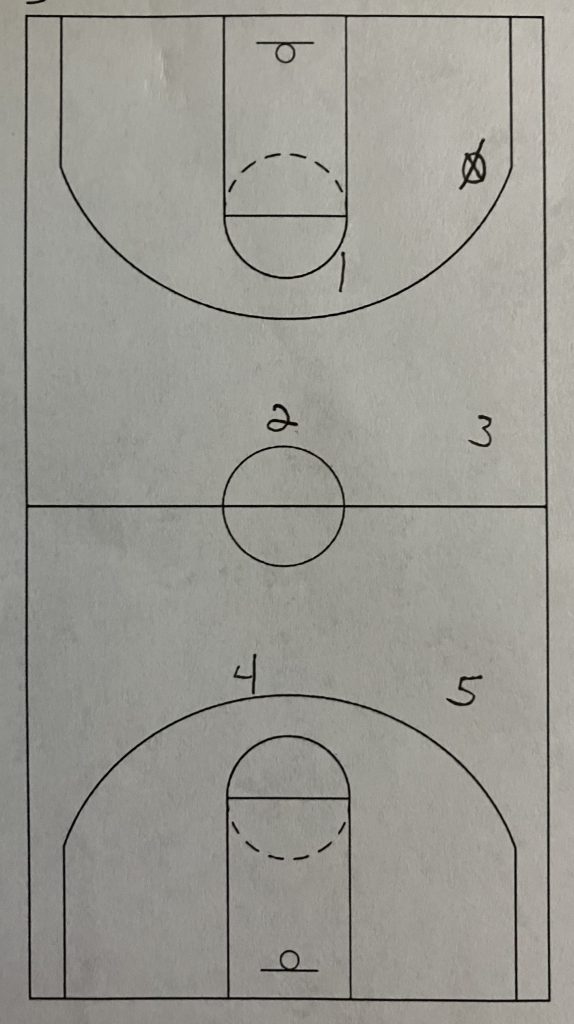
The point man is going to be active to get the ball to either sideline. The two guards and two back players will be working together. As one player moves towards the sideline, the other will be moving to the middle. An effective 1-2-2 press will have the guards working well together and the bigs working well together. While the guards and bigs do not have to move in sync with each other, most of the time they will be.
This is the basic formation and the players should stay in this setup throughout the entire possession. There is really no time when players should be overlapping or switching positions. The 1-2-2 press will keep the formation and try and get the ball into the trap zones.
Trapping in the 1-2-2 Press
The traps in the 1-2-2 press are generally going to occur at the half-court line or around the 3-point line on the sideline of the court. The most likely spot is at half-court with the point player and one of the guards. These first traps should occur right after the half-court line. Trapping before the half-court gives the offense the ability to go backwards to get out of the trap.
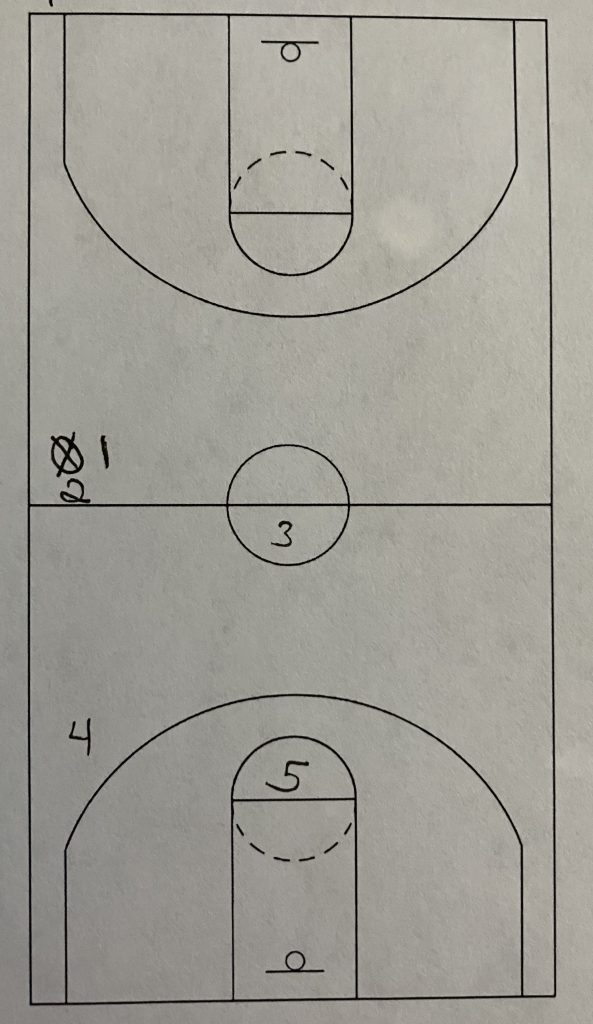
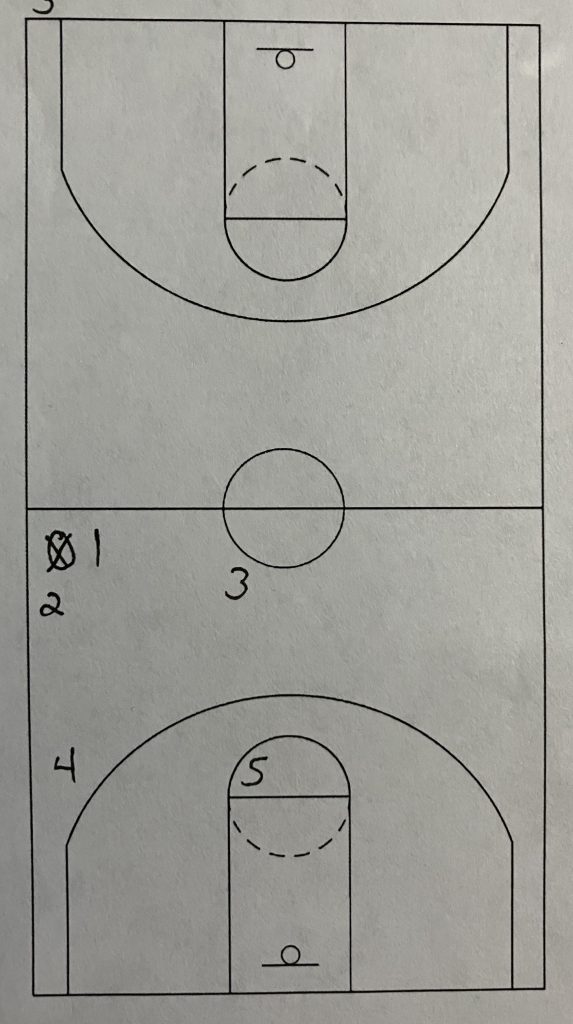
In the pictures above, it shows the difference between trapping before and after the half-court line. On the left, the trap happens before the offense crosses half-court. In this scenario they are able to go backwards to get out of the trap.
On the right when the ball does cross half-court before the trap, the trap is using the half-court line as another defender. In this case the offensive player being trap has no where to go. The defenders are in front of them and towards the middle of the court. The half-court line prevents the player from going backwards. And the sideline prevents the player from going to the outside of the court. This is where the trap needs to take place.
1 and 2 are trapping the ball. 3 is dropping into the middle taking away any pass out of the trap. 4 is on the sideline taking away any pass that may come down the sideline. And 5 is the rim protector dropping towards the front of the basket. Depending on where the offensive players are standing, the 5 will be somewhere in front of the basket up to the foul line.
These positions are the same whether the trap occurs before or after the half-court line. When the ball gets to this sideline, these are the rotations of the defense.
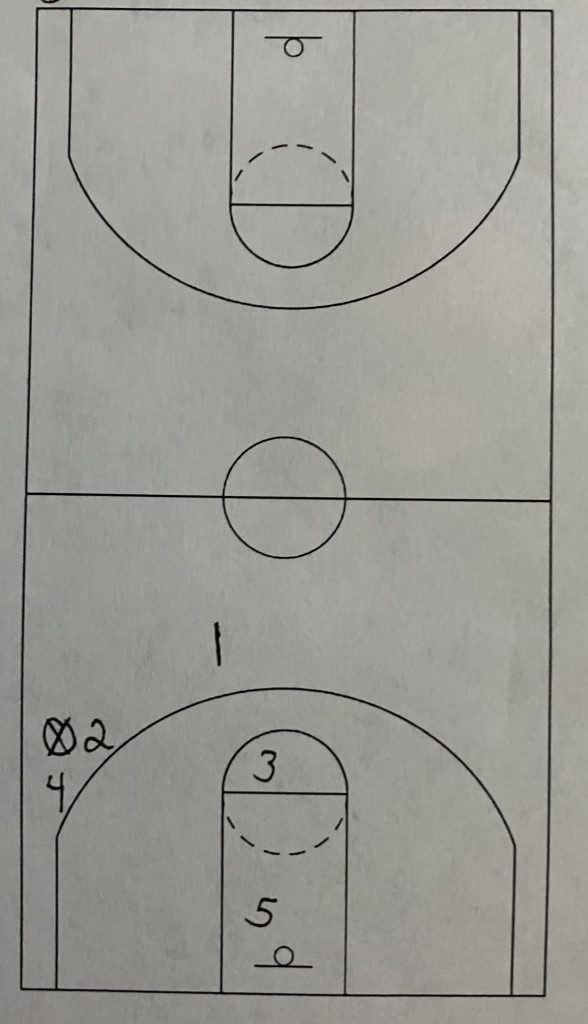
If a pass is able to be made up the sideline, then the 2 and 4 players have a chance for the trap. The four will stop the ball. The 2 guard will follow the pass to set the trap. The 1 or point player will drop into the middle. The 5 drops to the basket as rim protector. The 3 will take the elbow away.
If the offense has another player on ballside baseline, then the 5 rotates to the baseline, the 3 rotates to the rim, and the 1 drops to the elbow. It is unlikely the offense will have another player on the ballside baseline but it is possible. Any pass out of this trap will transition the defense out of the press and into the half-court defense.
If the ball is on the other side then the same rotates are occurring with the opposite players switching roles.
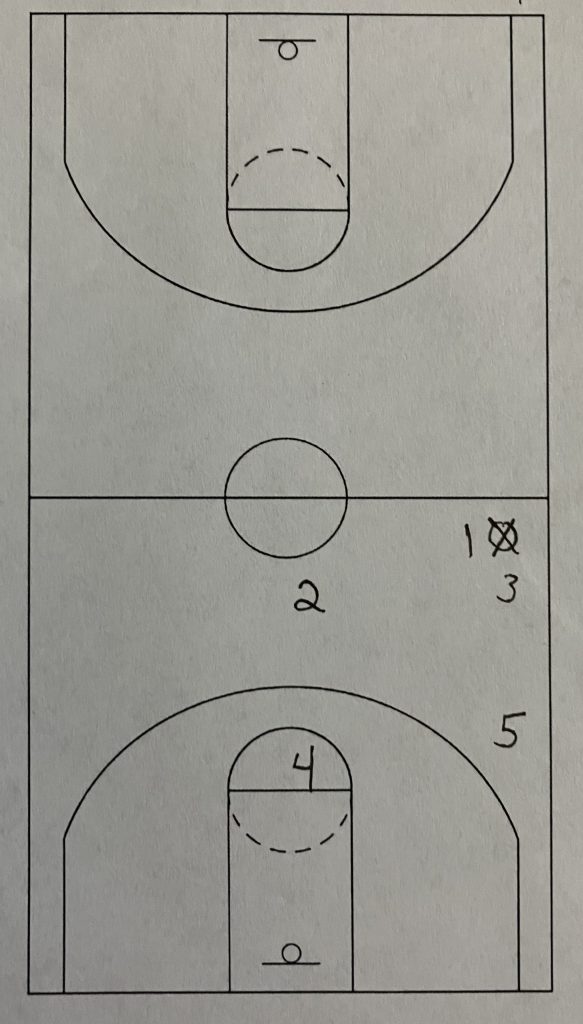
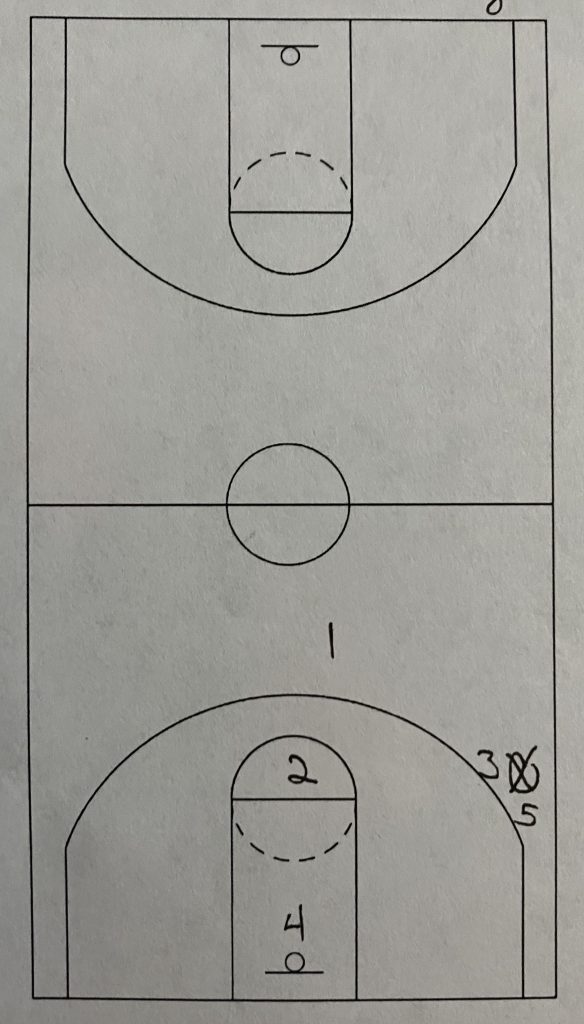
On the left, the 1 and 3 are trapping. 5 is taking the sideline pass away. 2 and 4 rotate into the middle of the court. On an advanced sideline pass, the 3 and 5 are trapping with the 1, 2, and 4 players dropping into the middle.
As you can see, each player is only required to move from the middle of the court out to the sideline. The exception is the point player.
Personnel Needed for the 1-2-2 Press
The reason most teams will go to the 1-2-2 Press is the team has two post players in the game at the same time. If neither of the post players are fast or mobile then the 1-2-1-1 Diamond Press or 1-3-1 Press are not options. That essentially leaves this 1-2-2 Press.
The 1-2-2 Press can keep a bigger slower team all on the court while still pressing. As the game is evolving and more players are learning and working on being outside offensive players, the defense will also become more outside focused. However, at the high school where a school team only has the players living in their district to pick from, there are going to be times where the best lineups have two bigger, slower players. This is where the 1-2-2 Press needs to be available for use.
The exception to this is the point player in the press. The point player needs to be long and athletic for the press to be most effective. They are the only player covering sideline to sideline. They are also up front trying to prevent reversal passes. The longer and more athletic this player is, the more likely they are able to keep the ball on one side of the floor. The point player in the 1-2-2 will be very similar to the point players in both the 1-2-1-1 Diamond Press and the 1-3-1 Press.
Keys to the 1-2-2 Press
1) Keep the Ball Out of the Middle
The 1-2-2 Press cannot pressure with the ball in the middle of the court. The problem is there is nobody directly assigned to the middle of the court. So, this is not always the easiest thing to do.
Personally, I will tell the players to allow the sideline dribble rather than the middle pass. The setup of the 1-2-2 press has the sidelines covered. So, a dribble up the sideline will eventually run into another defender. The press can trap early or late in the press so the ball placement does not matter on the trap. The press cannot trap with the ball in the middle. The basketball must be kept out of the middle of the court.
2) Trap after the Half-Court Line
The ability to reduce the places for the ball to be able to be passed too is a great win for the defense. A trap before the ball crosses the half-court line gives the offense a lot choices to get out of the trap. Trapping after the ball crosses half-court limits the spots on the court where the offense can pass the ball.
The 1-2-2 Press is not going to be having the players moving a lot so getting the chance to trap the ball in the most effective spots is difficult. Trapping too early makes the 1-2-2 press much harder to get steals and turnovers. The defensive players are not going to be chasing so they have to stay patient waiting for the offense to put the ball into the trapping zones. And patience is not always something players have.
3) Be Aggressive with the Front 3 and Conservative with the Back 2
The 1-2-2 press gives the defense a chance to play two slower post players. Bigger post players usually are good rim protectors. The back two players being bigger and slower need to understand this and play rim protector first. They do not need to be up gambling and leaving the other player back by themselves.
Since the back two players are not going to be really aggressive coming forward, the front 3 players can be more aggressive because they have rim protection behind them at all times. If the front 3 gamble and get out of position, they will have a good chance of getting back into the defensive possession because the rim protectors will not give up the easy layup. The offense will have to set their offense up in the half-court.
While all 5 defenders are playing together, the objective of the front 3 should be pressure and steals. The objective of the back 2 should be rim protection and stopping easy transition baskets. This press having separate objectives give the chance for steals while also preventing easy baskets.
This means the 1-2-2 press will not get as many steals or turnovers as another more aggressive press like the 1-2-1-1 Diamond Press, but the 1-2-2 press will also not give up easy layups when beat like the 1-2-1-1 Diamond Press does. The risk-reward ratio of the 1-2-2 is very low. Steals and turnovers will be down from other presses, but the 1-2-2 press will also not give up many easy layups when beat.
Youth Basketball and the 1-2-2 Press
At the youth level, I like the 1-2-2 press. Thinking is simplified. Rotations are simple and easy. As the players are young and their basketball IQ may not be very high, the rotations and placement of defenders are very easy for the players to understand. If the ball is on this side of the court, then everybody runs to that side. If the ball is on the other side, then every defender is over there.
Youth Basketball is sometimes best when it is the simplest. Among the presses, the 1-2-2 press has the least amount of thinking and reacting needed. Rotations are small. Traps are natural. All of these things make the 1-2-2 press a good choice for young players still learning the game of basketball. As the players get older and learn more about basketball, then more presses can be added. But the 1-2-2 press is a good choice as the first press installed at the youth level.
Conclusion
The 1-2-2 Press is better used with younger players. At the high school level and beyond the 1-2-2 press leaves the middle of the floor open. Opponents can exploit this flaw in the press. Most teams want to try and attack a press by going through the middle of the floor. The 1-2-2 press has its weakness as the very thing most opponents are trying to attack. This is a major problem in the press.
The greatest advantage the 1-2-2 press has is the ability to play two post players at the same time. Most presses and defenses are not designed to have two post players in the game at the same time. The 1-2-2 press and 1-2-2 half-court zone defense can play two post players without lessoning the quality of the defense.
A team that is playing with two post players would be a good team to use the 1-2-2 press. Teams that have only one post player on the floor or no post players on the floor might be better off playing a different press other than the 1-2-2 press. The game of basketball is moving more towards a positionless style where post players must be able to move and play on the perimeter. With this change, the 1-2-2 press might slowly be phased out of the game.
The 1-2-2 press is in the middle of being aggressive and conservative. It has great rim protection with the two players always in the back, but this prevents the press from being really aggressive. On the other hand, it is actively looking to trap the basketball which can lead to the offense having an advantage once through the trap. The 1-2-2 press is trying to be aggressive and conservative at the same time. It is a great option to put pressure on the opponent without extending too many players forward and leaving the team vulnerable in the back.

